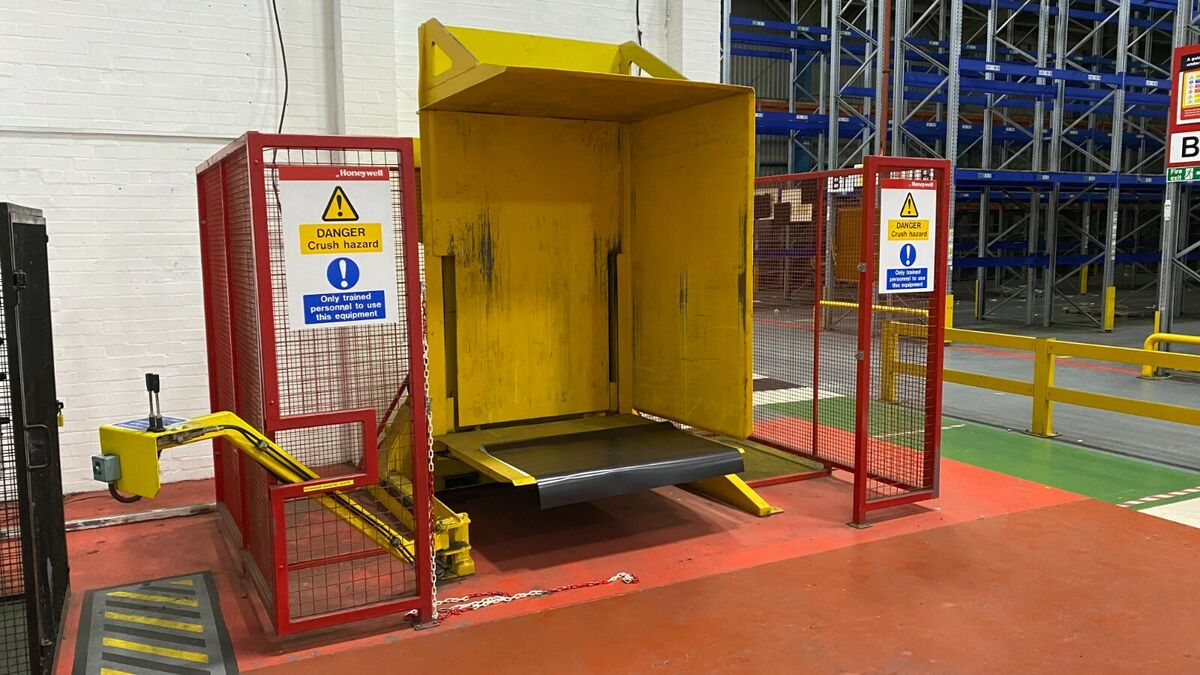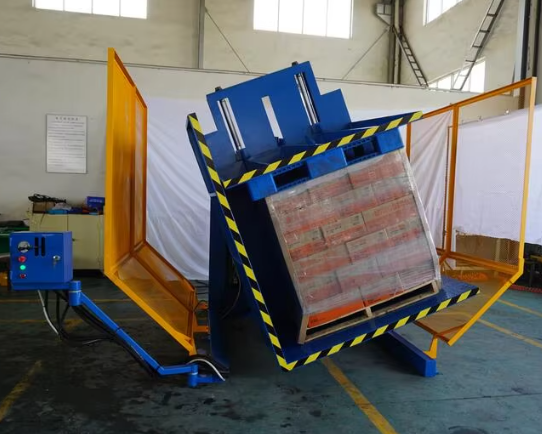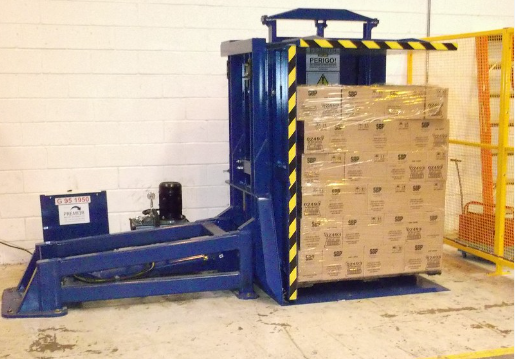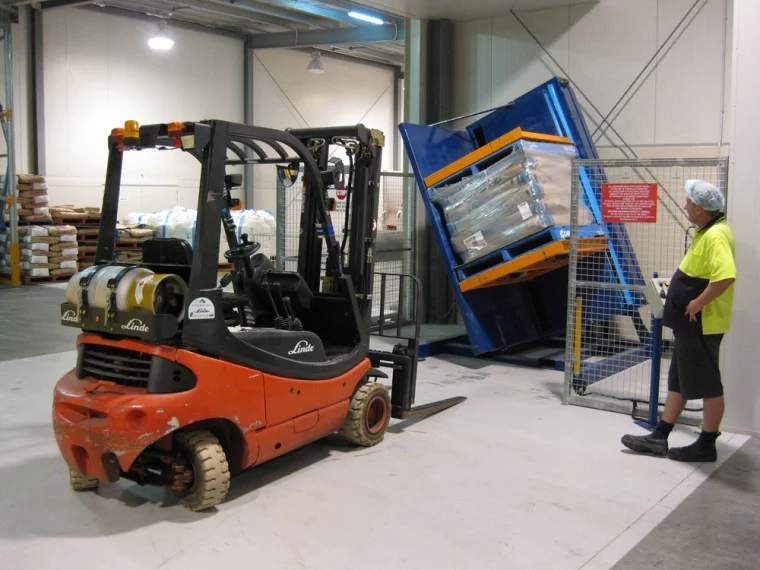Cutting Downtime in Indonesia: How Pallet Changing Machines Help
Are you watching your production line grind to a halt because of a simple bottleneck at the end? You have great machinery, skilled workers, and high demand, but everything slows down at the final step: palletizing and shipping. In the fast-paced manufacturing landscape of Indonesia, these small delays add up to huge losses. I’ve been there. I’ve walked factory floors and seen the frustration as teams struggle to manually transfer heavy loads from one pallet to another. This manual process is not just slow; it’s a major source of unexpected downtime, product damage, and even worker injuries. The good news is that there is a dedicated solution designed to fix this exact problem, a solution that turns your biggest bottleneck into a smooth, efficient operation.
Pallet changing machines help cut downtime in Indonesia by automating the slow, labor-intensive process of transferring goods between pallets. These machines replace inconsistent manual handling with a fast, repeatable, and safe automated cycle. This directly eliminates a major bottleneck in logistics and production, reduces the risk of product damage or worker injury that can stop a line, and allows for a continuous, predictable flow of goods. The result is a dramatic increase in operational uptime and overall factory output.

For any factory owner or manager, especially in a competitive market like Indonesia, efficiency is everything. You've likely invested heavily in optimizing your core production processes. But if the beginning or end of your line relies on slow, manual labor, you're leaving money on the table. It's a common oversight. We focus so much on the machines that make the product that we forget about the process of moving the product. In this article, I want to share my experience as an engineer and factory owner. We will explore exactly how a pallet changer works, the hidden costs it eliminates, and how it can become a cornerstone of a modern, efficient, and safe Indonesian factory. Let's look at the practical details.
How Can a Pallet Changer Directly Impact Your Production Line's Uptime?
Your production line is a chain, and it's only as strong as its weakest link. Is that weak link happening right before your products ship out? You might have a line that produces goods at an incredible rate, only to see finished products pile up, waiting for a team to manually transfer them from a factory pallet to a shipping pallet. This manual step is unpredictable. It can be fast one hour and slow the next, depending on the workers' energy or the difficulty of the load. This variability wreaks havoc on your schedule and creates frustrating delays. The solution is to make this step as reliable and predictable as the rest of your line. A pallet changer automates this entire process, transforming a major source of downtime into a swift, dependable, and integrated part of your workflow.
A pallet changer directly impacts uptime by replacing a variable, slow, and error-prone manual task with a consistent, fast, and automated one. Instead of your production line waiting for several minutes for a manual pallet swap, a machine can perform the same task in under 60 seconds. This saved time, multiplied over hundreds of pallets a day, translates directly into more available production time and higher overall throughput.

The Math of Minutes and Money
Let's think about this in practical terms. A manual pallet swap involves several steps. A forklift brings the pallet. Workers have to de-stack or manually shift the load. Then they re-stack it on the new pallet. This process can easily take 5 to 10 minutes per pallet, and that's if everything goes perfectly. If the load is unstable or heavy, it takes even longer. Now, contrast this with an automated pallet changer. The forklift places the pallet into the machine, the machine executes its cycle, and the forklift removes the pallet with the new base. The entire process is often completed in about one minute.
| Parameter | Manual Pallet Swap | Automated Pallet Changer | Impact |
|---|---|---|---|
| Time per Pallet | 5 - 10 minutes | ~1 minute | 80-90% time reduction per cycle |
| Labor Required | 2-3 workers | 1 operator (can oversee multiple) | Significant labor cost savings |
| Consistency | Variable; depends on workers | Highly consistent cycle time | Predictable production flow |
| Throughput (Pallets/Hour) | 6 - 12 | 40 - 60 | 400%+ increase in throughput |
This table doesn't just show time savings. It shows a transformation in predictability. When you can accurately predict that every pallet exchange will take one minute, you can schedule your production and logistics with much greater precision. This relates directly to the goal of increasing equipment effective run time. The time your main production machines spend waiting is pure downtime. By drastically cutting that waiting time, the pallet changer ensures your primary assets are running more often.
Eliminating Unplanned Stops
Downtime isn't just about scheduled slowness; it's also about unplanned stops. Manual handling is a major cause of these sudden interruptions. A tired worker might accidentally drop a box, damaging the product and requiring a cleanup. A poorly stacked load could collapse, creating a safety hazard and a significant delay. Worst of all, manual lifting of heavy loads is a leading cause of back injuries, which can take a key team member off the line for weeks and lead to insurance claims.
Each of these events triggers unplanned downtime. The line stops. Managers have to intervene. The area needs to be cleared. An automated pallet changer mitigates these risks almost entirely. The machine is designed to handle loads securely. Clamping mechanisms hold the product firmly but gently. The transfer is smooth and controlled. This built-in reliability prevents the product damage and safety incidents that cause these sudden, costly stops. It turns an unpredictable risk into a managed, safe process.
What Are the Hidden Costs of Manual Pallet Handling in Indonesian Factories?
When you look at your operational budget, you see the direct cost of labor for your warehouse staff. But that number is only the tip of the iceberg. The true cost of relying on manual pallet handling is much higher, hidden in expenses that don't always appear on the same line item. Have you calculated the cost of products damaged during transfer? Or the financial impact of a single workplace injury? What about the lost business from delayed shipments? These hidden costs accumulate over time, silently eating into your profit margins. Recognizing and quantifying these expenses is the first step toward understanding the powerful return on investment that automation, like a pallet changer, can provide.
The hidden costs of manual pallet handling in Indonesian factories extend far beyond direct wages. They include the significant expense of replacing products damaged from being dropped or crushed, the high cost of workers' compensation claims from lifting injuries, and the huge opportunity cost of lost production caused by an inefficient and slow logistics bottleneck. These factors combine to make manual handling far more expensive than it appears on the surface.

The Compounding Cost of Damaged Goods
Let's do some simple math. Imagine your factory ships out 200 pallets per day. If manual handling results in just a 1% product damage rate, that's two pallets' worth of goods lost every single day. If the value of goods on each pallet is, say, $1,000, that's a $2,000 loss daily. Over a year, that single percentage point costs you over half a million dollars. This doesn't even account for the cost of disposal, the labor needed to sort the damaged goods, or the reputational damage if a customer receives a partially damaged shipment.
A pallet changer is engineered for gentle handling. The clamping pressure is adjustable to suit the product, whether it's sturdy boxes or fragile bags. The rotation or push-off motion is smooth and controlled. This precision reduces the damage rate to near zero. It protects the product itself and the primary packaging, ensuring it arrives at the customer in perfect condition. This isn't just cost savings; it's quality assurance.
The High Price of Worker Safety and Morale
Manual handling of heavy loads is inherently risky. In Indonesia, like everywhere else, workplace safety is a growing concern. A single serious back injury can lead to enormous costs, including:
- Medical bills and insurance premium hikes.
- Lost productivity from the absent employee.
- The cost of hiring and training a temporary replacement.
- Potential regulatory fines if safety protocols are found lacking.
Beyond the direct financial costs, there's the impact on team morale. A job with a high risk of injury leads to higher employee turnover and lower engagement. It's hard for people to feel motivated when their work is physically punishing. Automating this task with a pallet changer removes the most strenuous physical activity from their daily routine. This demonstrates a commitment to employee well-being, which can improve retention, boost morale, and create a safer, more positive work environment. A happy, safe team is a more productive team. This intangible benefit is one of the most powerful returns on your investment.
How Do Modern Pallet Changers Integrate with Existing Digital Systems?
You have probably invested in digital platforms to run your factory more intelligently. Maybe you have a Manufacturing Execution System (MES) to track production in real time or a Warehouse Management System (WMS) to manage inventory. But what happens when a piece of equipment is an "island," unable to communicate with these systems? You create a blind spot in your data. You know what goes into the packaging line and what comes out, but the process itself is a black box. This is a common frustration for forward-thinking managers. The great news is that modern packaging machinery, including pallet changers, is no longer built in isolation. They are designed to be a fully integrated part of your factory's digital ecosystem.
Modern pallet changers integrate with existing digital systems like MES and WMS through their onboard Programmable Logic Controller (PLC). The PLC can communicate using standard industrial protocols like Profinet or Ethernet/IP. This connection allows the pallet changer to send real-time data—such as cycle counts, machine status, and fault diagnostics—to your central management platform and receive commands, creating a seamless, automated, and fully visible workflow.

The PLC: The Machine's Brain and Voice
At the heart of every modern automated machine is a PLC, or Programmable Logic Controller. Think of it as the machine's dedicated computer. It controls all the machine's actions: when the clamps engage, how fast the platform rotates, and when the cycle is complete. But just as importantly, the PLC can communicate. It can send and receive signals to and from other systems. This is the key to integration.
When we install a pallet changer, one of the first things we discuss is how it will connect to the factory's network. The PLC can be configured to "talk" to your MES. For example, when a pallet cycle is complete, the PLC can send a signal that automatically updates your inventory in the WMS. It can count each pallet and send that data to your production dashboard, giving you a live, accurate measure of throughput. This removes the need for manual data entry, which is both slow and prone to errors. It provides the "comprehensive production visualization" that so many managers are striving for.
From Reactive Repairs to Predictive Maintenance
One of the most powerful benefits of digital integration is the shift toward predictive maintenance. This directly addresses the challenge of aging equipment and rising failure rates. A basic machine just works until it breaks. A modern, connected machine tells you when it's going to break before it happens.
This is achieved through IoT (Internet of Things) sensors. A pallet changer can be equipped with sensors that monitor:
- Motor Vibration: An increase in vibration can signal a bearing is beginning to fail.
- Hydraulic Pressure: A drop in pressure could indicate a slow leak.
- Cycle Count: The PLC can track the total number of cycles, and you can schedule maintenance (like replacing a wear part) after a certain number of uses, not just after a fixed time period.
This data is sent from the PLC to your maintenance system. Instead of waiting for a breakdown that stops your entire shipping department, your maintenance team gets an alert: "Motor 3 on Pallet Changer 1 shows increased vibration. Please inspect." This allows you to schedule repairs during planned downtime, like overnight or on a weekend. This is a game-changer for achieving high uptime, moving from fighting fires to preventing them.
Beyond Speed, What Safety and Quality Benefits Do Pallet Changers Offer?
When business owners first look at a pallet changer, their primary focus is usually on speed and labor savings. These are important, of course. But to only focus on speed is to miss some of the most profound benefits of this technology. A production line that is fast but unsafe is a liability. A line that is fast but damages your product is just producing waste more quickly. True operational excellence comes from a balance of speed, safety, and quality. You cannot sacrifice one for the others. The reality is, a well-designed pallet changer isn't just a machine for going faster; it's a tool for operating better and safer, protecting both your valuable product and your most valuable asset—your people.
Beyond speed, pallet changers offer transformative safety and quality benefits. They create a fundamentally safer work environment by removing the need for manual heavy lifting, which is a primary cause of workplace injuries. At the same time, they enhance product quality by providing gentle, consistent, and secure handling, which prevents damage to both the goods and their packaging during the critical pallet transfer process.

Engineered for Product Integrity
I remember a client in the food and beverage industry in Jakarta. Their biggest challenge wasn't speed; it was hygiene and quality control. They needed to move their finished goods from wooden pallets, which they used inside the factory, to clean, plastic pallets for export to meet international standards. Their manual process was a huge risk for contamination. Workers were handling the product directly, and the slow process left it exposed.
We installed a pallet inverter for them. This machine clamps the load, rotates it 180 degrees, and allows for the source pallet to be easily removed from the top. Then, the new plastic pallet is placed on, and the machine rotates back. The product is handled securely by the machine's padded clamps the entire time, never touched by human hands during the transfer. This solved their primary problem of hygiene. It guaranteed they met export compliance. As a bonus, it was also dramatically faster and safer for their employees. They initially came to us with a logistics problem, but the solution also solved a major quality control challenge. This is a perfect example of how these machines offer benefits beyond simple speed. They are precision tools that protect the value you've worked so hard to create in your product.
A Culture of Safety
Creating a safe workplace is a leader's responsibility. It is also good business. A pallet changer is a visible and powerful statement about your company's commitment to safety. It is equipped with multiple safety features as standard:
- Safety Fencing: A physical barrier prevents anyone from accidentally walking into the machine's operational area.
- Light Curtains: These are infrared beams that, if broken by a person or object, will instantly stop the machine's motion.
- Emergency Stop Buttons: These are placed at multiple, easily accessible points for immediate shutdown.
By automating the most physically dangerous task in the logistics chain—lifting and moving pallet-loads weighing over a ton—you are designing the risk out of the process. This isn't just about preventing costly accidents. It's about building a culture where employees know that their well-being is a top priority. That kind of culture is invaluable and leads to a more dedicated and careful workforce across the entire factory floor.
Conclusion
A pallet changer is a strategic tool. It cuts downtime, lowers hidden costs, and boosts safety and quality, helping Indonesian factories become more competitive and resilient in a demanding market.




